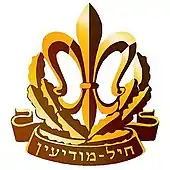Military Intelligence Directorate (Israel)
The Israeli Military Intelligence (Hebrew: אגף המודיעין, Agaf HaModi'in – lit. "the Intelligence Section"), often abbreviated to Aman (Hebrew: אמ״ן), is the central, overarching military intelligence body of the Israel Defense Forces. Aman was created in 1950, when the Intelligence Department was spun off from the IDF's General Staff (the Intelligence Department itself was composed largely of former members of the Haganah Intelligence Service). Aman is an independent service, and not part of the ground forces, Navy or the Air Force.
| Military Intelligence Directorate Israeli Military Intelligence אגף המודיעין | |
|---|---|
 | |
| Common name | Aman |
| Agency overview | |
| Employees | classified |
| Jurisdictional structure | |
| National agency | Israel |
| Operations jurisdiction | Israel |
| Governing body | IDF General Staff |
| Operational structure | |
| Agency executive |
|
It is one of the main entities (and the largest component) of the Israeli Intelligence Community, along with Mossad and Shin Bet. It is currently headed by Major General Tamir Heiman. It includes the cyber warfare branch Unit 8200 and the training course Havatzalot Program. Its special forces unit is Sayeret Matkal.
Roles and jurisdiction


The IDF's Intelligence Corps (חיל המודיעין), abbreviated as Haman (חמ"ן) and headed by a brigadier general, has been detached from Aman since the Yom Kippur War, but remains under its jurisdiction.
In April 2000, the newest IDF corps was founded (the IDF's fifth land corps), the Combat Intelligence Collection Corps (חיל מודיעין השדה), abbreviated as Modash (מוד"ש). It was designed to fulfill some of Aman's former combat intelligence functions, and is also headed by a Brigadier General. Although it falls under the operational jurisdiction of the GOC Army Headquarters, it also falls under Aman's professional jurisdiction.
In 1976, according to the Lexicon of National Security, some of Aman's principal roles consisted of:
- Intelligence evaluation for security policy, military planning and "fluid security policy," and the dissemination of intelligence to IDF and governmental bodies.
- Field security at the level of the General Staff (today, Matkal: מטכ"ל), and the training and operation of field security in general (all levels).
- The operation of military censorship.
- Direction and operation of the 'Collection Agencies'.
- Drawing maps; providing the direction and supervision for the dissemination of maps.
- The development of 'special measures' for intelligence work.
- The development of intelligence doctrine in the realms of research, collection, and field security.
- Staff responsibility for military attachés overseas.
History
During the founding of the state of Israel, the Haganah military organization was primarily responsible for gathering intelligence, or one of its elite units, the Scherut Jediot (secret service), or Shai.
Prime Minister David Ben Gurion commissioned the Shai in the late 1940s to create a secret service structure for Israel. Shai member Re’uwen Schiloach established based on Shai four independent services: Aman and Schin Bet and also the foreign intelligence service Machleket Hacheker and the Institute for Illegal Immigration Mossad le-Alija Bet (defunct in March 1952). In addition, in mid-1949 Shiloah created the Committee of Secret Service chiefs as a super-ordinate body. From 1963 the international secret service was officially called "Institute for Intelligence Service and Special Tasks" (ha-Mosad le-Modi'in u-le-Tafkidim Mejuhadim), short Mossad.
An offshoot of the Department of Defense was also the lesser-known Lakam technology intelligence agency. The existence of which was long considered a state secret. It was used to obtain scientific and technological information. In the 1980s, however, the Lakam lost much of its previous importance.
One of the biggest defeats of the Israeli secret services was caused by the Aman in the 1950s. Defense Minister Pinhas Lavon had to resign as part of the so-called Lawon affair. Aman-led "Operation Susannah" was intended to attack western facilities in Egypt by Israeli agents and saboteurs. The aim was to disrupt the good ties between the United States and the Egyptian head of state, Gamal Abdel Nasser. The US should believe that the Egyptian state is powerless against religious organizations. Egypt managed uncover the agent circle. Ten members were sentenced in a show trial in January 1955, two of them to death. Lawon resigned a month later, then Benjamin Gibli, then Aman's director, two weeks later. Ultimately, Head of State Ben Gurion resigned in 1963 after being worn down by ongoing discussions.
Units
Aman consists of the following subordinate and professionally subordinate units:
Staff units
Research
Information security
- Information Security Department
- Military Censor [Part of Aman, but an entirely independent unit, not subordinate to any military or political level, only to parliamentary and judicial oversight]
Other units
- Supervision Department
- External Relations Department
- Ro'im Rachok
- Unit 81
- Havatzalot Program
Professionally subordinate units
- Air Intelligence Group: the intelligence unit of the Israeli Air Force
- Naval Intelligence Division: the intelligence unit of the Israeli Sea Corps
- Combat Intelligence Collection Corps: the intelligence unit of GOC Army Headquarters
- The intelligence units of the Regional Commands: Central, Northern, Southern and Home Front Commands
- Center for Consciousness Operations: a psychological warfare unit of the Operations Directorate
List of directors
The head of Aman is the senior intelligence officer in the IDF and engages in intelligence decision and policy-making at the same level as the heads of the Shabak and the Mossad: together, they form the three highest-ranking, co-equal heads of the Israeli Intelligence Community, focusing on the military, domestic (including the Palestinian territories), and foreign intelligence fronts respectively.
On June 10, 2005, then-IDF's Chief of Staff, Lieutenant General Dan Halutz, in a move viewed as surprising, announced that Major General Aharon Zeevi-Farkash would be replaced by Major General Amos Yadlin. Yadlin, who had been serving as the IDF's military attaché in Washington, D.C., was a combat pilot, former head of the air force's Air Intelligence Directorate, and Halutz's deputy. Yadlin was appointed as Aman Director on January 5, 2006, with Zeevi-Farkash having served an extended term. In November 2010 Yadlin was replaced by Major General Aviv Kochavi.
- 1948–1949: Isser Be'eri
- 1949–1950: Colonel Chaim Herzog
- 1950–1955: Colonel Binyamin Gibli
- 1955–1959: Major General Yehoshafat Harkabi
- 1959–1962: Major General Chaim Herzog
- 1962–1963: Major General Meir Amit
- 1964–1972: Major General Aharon Yariv
- 1972–1974: Major General Eli Zeira
- 1974–1978: Major General Shlomo Gazit
- 1979–1983: Major General Yehoshua Saguy
- 1983–1985: Major General Ehud Barak
- 1986–1991: Major General Amnon Lipkin-Shahak
- 1991–1995: Major General Uri Sagi
- 1995–1998: Major General Moshe Ya'alon
- 1998–2001: Major General Amos Malka
- 2001–2006: Major General Aharon Zeevi-Farkash
- 2006–2010: Major General Amos Yadlin
- 2010–2014: Major General Aviv Kokhavi
- 2014–2018: Major General Herzi Halevi
- 2018–present: Major General Tamir Haiman
References
External links
- GlobalSecurity.org on Aman (1996)
- "Israeli Intelligence in the 1967 War," By Doron Geller, JUICE, The Jewish Agency for Israel, Education Dept.
- "Israeli Intelligence and the Yom Kippur War of 1973," By Doron Geller, JUICE, The Jewish Agency for Israel, Education Dept.
- The "Yom Kippur War: the IDF version," by Amir Oren, for Haaretz
- "Intelligence service under scrutiny," by Dan Baron, for the Jewish Telegraphic Agency